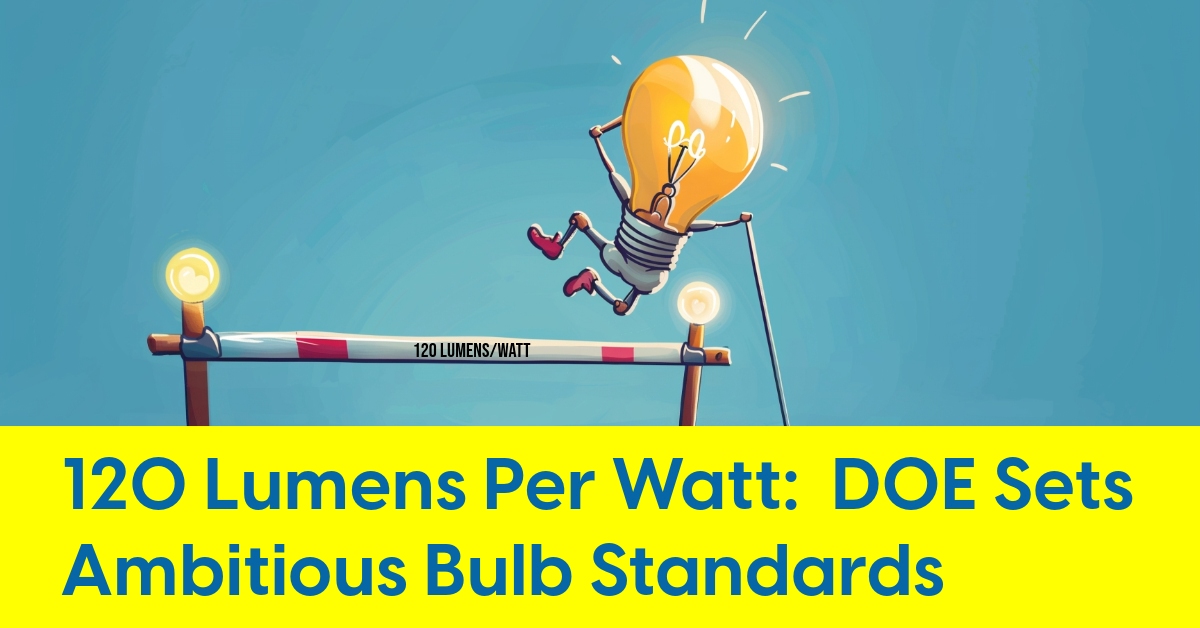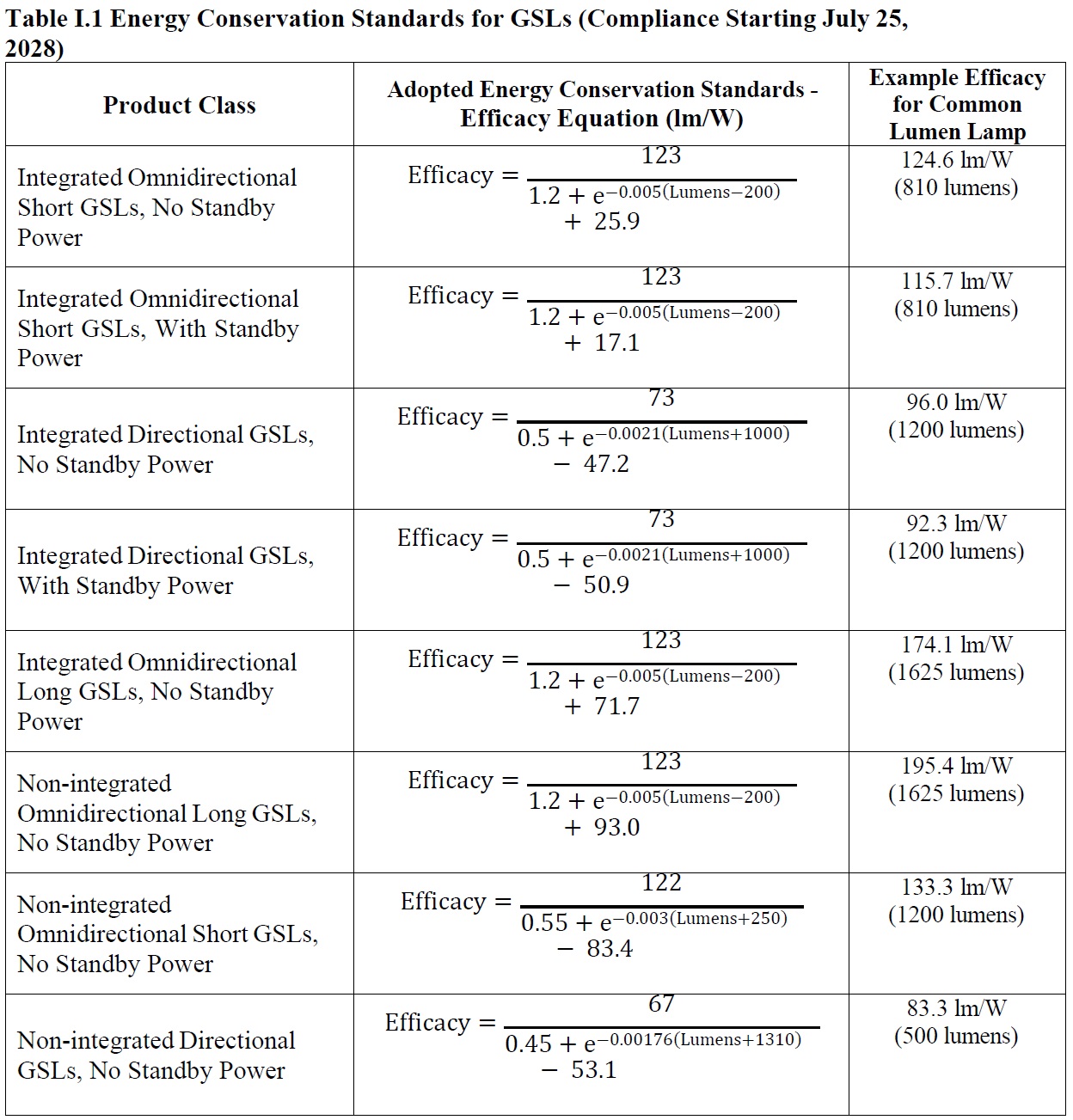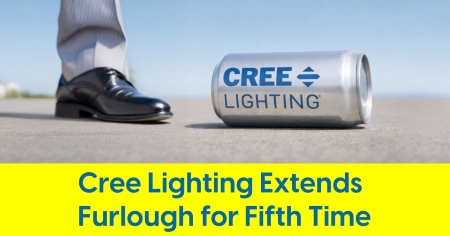April 15, 2024
120 Lumens Per Watt: DOE Sets Ambitious Bulb Standards

New Department of Energy rule set to mandate dramatic increase in lamp efficacy, starting 2028
The U.S. Department of Energy (DOE) has announced an update to its energy conservation standards for general service lamps marking a significant leap in minimum efficacy requirements for lighting. The new regulations, known as the final rule, mandate that all general service lamps must achieve at least 120 lumens per watt for the most common lamps, a stark rise from the current standard of 45 lumens per watt.
A "final rule" in regulatory terms is the last step in the process of creating or revising a federal regulation. It follows a period of proposal, public commentary, and review, concluding with the official codification of new standards that entities must comply with by a specified date.
In the case of general service lamps, this final rule, published last week, sets forth compliance requirements that will begin in mid-2028. This move by the DOE aims not only to phase out less efficient compact fluorescent lamps but also to capitalize on the energy-saving and cost-effective benefits of LEDs. Lighting currently accounts for a significant portion of energy use in both commercial and residential settings, underlining the impact potential of these updated standards on national energy consumption.
New Standards in Detail
The revised standards are part of the DOE's ongoing efforts under the Energy Policy and Conservation Act (EPCA), which mandates regular updates to ensure that energy conservation standards for consumer products remain in step with technological advancements. The new rule stipulates that all general service lamps manufactured in or imported into the U.S. must meet these heightened efficacy criteria starting on July 25, 2028.
Here is a brief overview of the efficacy standards for various general service lamps as detailed in the final rule:
-
Integrated Omnidirectional Short General Service Lamps: Minimum efficacy of 124.6 lumens per watt (lm/W) for a typical 810-lumen lamp.
-
Integrated Directional General service lamps: Minimum efficacy of 96.0 lm/W for a 1200-lumen output.
-
Non-integrated Omnidirectional Long General Service Lamps: A significant 195.4 lm/W for lamps emitting 1625 lumens.
These standards represent a substantial improvement over the current minimum of 45 lm/W established in the previous rulemaking cycle.
Implications for Manufacturers and Consumers
Meeting the new efficacy standards of more than 120 lumens per watt may prove to be a formidable task for manufacturers of certain LED lamps. These standards challenge the balance between lamp efficacy, color quality, and design complexity. Below are details on specific LED lamp types that may struggle to meet these standards:
Color Tunable (Full RGB) LEDs: Full RGB LEDs allow users to choose from a spectrum of thousands or millions of colors. However, the efficiency of these LEDs varies with the color produced. Deep blues and vibrant reds, for example, are less efficient in converting electricity to visible light than greens or whites. The varying efficiencies across the color spectrum mean that while some settings may meet efficacy standards, others will not, complicating consistent compliance.
White Tunable (Adjustable CCT) LEDs: These lamps can typically adjust their color temperature from warm white (about 2700K) to cool white (up to 5000K or more). They achieve different color temperatures by blending light from LEDs with different spectral outputs, which may not all be equally efficient. It is challenging to maintain high efficacy across the entire tunable range because the phosphors used to convert blue LED light into longer wavelengths (necessary for warmer colors) can diminish total light output per watt.
High CRI LEDs: High Color Rendering Index (CRI) LEDs are engineered to more accurately render the colors of the objects they light, closely resembling natural light. Enhancing color rendering typically involves using additional phosphors or LEDs that emit in less efficient parts of the spectrum. These additional requirements can decrease the overall efficacy of the lamp, making it more difficult to achieve higher standards.
The adoption of these standards involves a balanced consideration of technological feasibility, economic justification, and potential energy savings. The DOE's analysis predicts positive life-cycle cost savings for consumers across all product classes, indicating that the increased upfront costs are more than offset by the decreased operating costs over the products' lifetimes.
For manufacturers, the transition to these new standards entails significant adjustments. The industry is expected to face an increased financial burden due to compliance costs. However, according to the DOE these costs are considered manageable within the broader context of national energy savings and environmental benefits.
DOE Claims that 4 Quadrillion BTUs will be saved
According to the DOE's estimates, the standards will save about 4.0 quadrillion British thermal units of energy over 30 years, which correlates to a reduction of 70.3 million metric tons of carbon dioxide emissions. These savings contribute significantly to national efforts to reduce energy consumption and mitigate environmental impacts.
Following the publication of the final rule on energy conservation standards for general service lamps, the next steps include a period for industry adjustment and preparation for compliance with the new requirements by July 25, 2028. The DOE will also continue to provide guidance and support to manufacturers and stakeholders to help ensure a smooth transition to the higher efficiency standards.
The DOE's new final rule elevates the efficacy bar for general service lamps to at least 120 lumens per watt by 2028, a considerable jump from the current 45 lumens per watt standard. This advancement may pose challenges for manufacturers in balancing lamp efficacy with color quality and complexity in design. While these standards promise efficiency, questions about the potential impact on the quality of light and other important related factors may arise within the industry.











